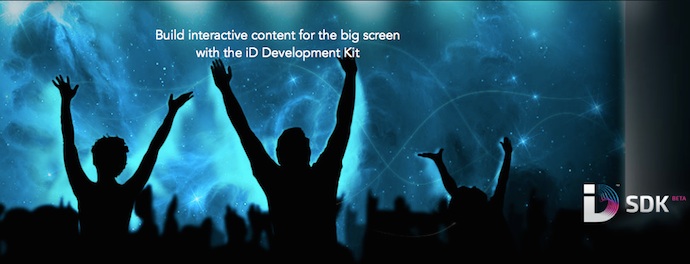You may soon be doing more twisting, turning, and jumping around when you go to the movies, if startup Audience Entertainment succeeds in launching a new type of in-theater interactivity.
The company’s technology basically allows audiences to play together, usually as part of an ad campaign. Imagine standing up with everyone else in the room, then waving your arms left and right in unison to control the game onscreen. That’s essentially what the company promises, and it’s actually brought these experiences into theaters, for example allowing audiences to control Donald Duck as he slides down a waterslide as part of a promotion for Disney Cruise Lines.
Founder and CEO Barry Grieff (whose decades of ad experience include a stints at National Lampoon Magazine, Rolling Stone, and Interpublic Group) argued that we’re in the middle of “a sea change in content creation,” moving away from linear content and towards interactivity. He’s hoping to bring that shift into movie theaters and other locations like arenas and concerts venues, by installing cameras to capture motion and sound. Comparing it to 3D, Grieff described this interactive experience as “iD”.
To move beyond one-off experiments and individual campaigns, Audience Entertainment needs to put its tools into the hands of more developers, advertisers, and filmmakers. And that’s why it’s announcing a software development kit that will allow third parties to create content for the platform.
The company plans to launch the SDK on Sept. 29, during Advertising Week, but it’s already taking early beta signups here. When asked about the extent to which Audience Entertainment will control the content on its network, Chief Marketing Officer Adam Cassels said that as the platform opens up, the company will be serving as “a conduit to interactive content” and will continue to perform “quality assurance.”
When I first heard the pitch, I thought of previous failed experiments in “interactive cinema“. But then I had a chance to try out the technology for myself — sadly not in a crowded movie theater, but using the camera in the Audience Entertainment conference room. As I played one of the games, I found myself enthusiastically (if awkwardly) jumping around in my seat to touch different cubes as they appeared onscreen.
Since the platform is trying to combine the actions of dozens or hundreds of people, you can’t have particularly fine grained controls — but perhaps we’ll see more creative uses of the group dynamic after the SDK goes live. And when it comes to advertisers, at least, the goal isn’t to create a deep game that you can play for hours. Instead, it’s about getting viewers to engage with the ads onscreen, even if only for 30 or 60 seconds, rather than just checking Facebook and Twitter while they wait for the movie to start.
You can see more examples in the video below, and in this proof-of-concept game. (Though with the game, presumably you’re using a mouse to play in your home or at the office, so you’ll have to imagine the part where you’re in a theater, waving your arms around to make different choices, and maybe shouting at the people next to you.) Oh, and in terms of actually getting the technology into theaters, Audience Entertainment announced a partnership with digital cinema company Barco earlier this year, with the aim of bringing iD to 3,000 screen worldwide.
Audience Entertainment 2014 Showreel from Audience Entertainment on Vimeo.
